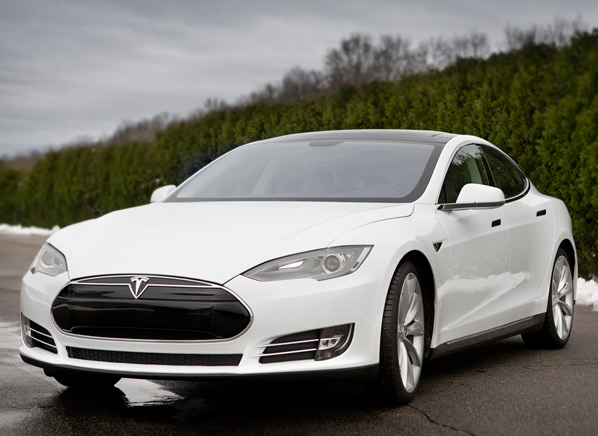If you ask Tesla, they'll tell you the company's mission is not just to build a better car, but to change the world. And they are off to an exciting start.
The roadster was the company's first salvo into the car business. That $110,000 converted Lotus Elise has been phased out. The company is now ramping up production of the Model S, a largish all-aluminum luxury car that the California startup began selling over the summer. (Read our first drive report on the Tesla Model S.)

The Model S is about the size of other midsized luxury sedans, such as the BMW 5 Series and Mercedes-Benz E-Class. But the car seats seven, rather than five passengers, thanks to an optional small rear-facing jump seat tucked inside its cavernous hatchback.
The front seats are commodious, too. Tesla has ripped a page from General Motors' concept-car playbook and developed the Model S on a "skateboard" chassis. This design is well suited to electric cars in which all the car's mechanical components—the battery, motor, suspension, etc—are packaged into a flat floor. And the body essentially sits on top of it.
This approach has several benefits: It creates an utterly flat floor inside, which opens up interior space compared to other luxury cars that have a center tunnel running through the floor. That packaging advantage brings tremendous benefits to interior storage and leg room. Without an engine, and with the batteries mounted in the floor, the skateboard chassis also frees up a moderate front trunk underneath the "hood." Tesla representatives call it the "frunk." It'll fit a large suitcase and a duffel or three, in addition to the already generous cargo space inside the hatchback.

The skateboard chassis will bring economies of scale for Tesla to create other models based on the Model S. Next up: a seven-passenger SUV called the Model X, on the same chassis due in 2014.
And finally, the batteries under the floor make it easy for Tesla to design in and install different batteries. In the Model S's case, the car will eventually be sold with a choice of three batteries, one EPA-rated with a 120-mile range, another good for 180-miles, and the 265-mile model currently in production.
Interesting trivia: The batteries can be swapped in about 15 minutes, Tesla representatives say. However, the idea isn't to change a smaller battery for a larger one or vice versa, or even to hot-swap discharged batteries, because the suspension of each car is optimized for the weight of the battery it was sold with.
The only model available now is the top-of-the-line Signature series, with the largest, 85 kWh battery. That's twice the size of the battery in the Toyota RAV4, the next largest EV on the market, and about four-times the size of the typical electric-car battery. Still, Tesla says the battery can be fully charged in 8.5 hours—about as long as it takes a Nissan Leaf. The Model S uses a dedicated charge cord that can be plugged into any standard J1772 electric car charge plug, or a household 110-volt or 240-volt outlet using various adapters (kept in a bag in the trunk). The fastest (8.5-hour) charge comes by plugging directly into a household 240-volt outlet. Faster still is a dedicated Tesla High Power Connector that can charge the car in 5 hours.
Inside, the Model S houses almost all its controls in a 17-inch touchscreen on the center of the dash. A permanent 3G cellular connection allows Tesla to continually update software, and even add controls, on the fly. For example, the company plans to push out 4G software soon, and it has added a button to install a second regenerative brake setting for drivers who don't like it so aggressive.
Otherwise, Tesla also aims to remake the car-buying experience in the vein of Apple stores, with one or two cars in a bright, clean mall location, where customers can (in some states) place an order, or visit the company's website. The company says the traditional franchised dealer model won't work for electric cars, because dealers make the bulk of their profits in later service work on the cars they sell. Dealers in two states have sued. And some early Model S owners have complained in electric-car forums about an annual $600 maintenance fee Tesla requires.
We've been impressed with our initial drives of the Model S, as highlighted in the video below. But when you're out to change the world, you can expect some resentment. It will be interesting to see how far Tesla gets.
Related:
Tesla Model S - The electric car that shatters every myth
See our guide to alternative fuels.
—Eric Evarts





